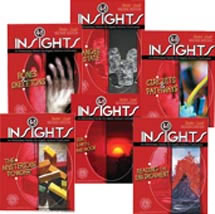Insights: An Inquiry-Based Elementary School Science Curriculum (Fourth and Fifth Grade Modules)
By Karen Worth and the Insights Elementary Project Staff
 Insights is an innovative, inquiry-based, hands-on science curriculum for elementary school students. The full curriculum consists of 21 modules that represent a balance of life, earth, and physical science. The modules also highlight six major science themes: systems, change, structure and function, diversity, cause and effect, and energy. Each module is made up of a carefully sequenced, age-appropriate set of hands-on experiences designed to be directly relevant to the child. The modules are designed for use in self-contained elementary classrooms, and can be used as a core curriculum to be expanded as necessary, or individually in conjunction with existing programs.
Insights is an innovative, inquiry-based, hands-on science curriculum for elementary school students. The full curriculum consists of 21 modules that represent a balance of life, earth, and physical science. The modules also highlight six major science themes: systems, change, structure and function, diversity, cause and effect, and energy. Each module is made up of a carefully sequenced, age-appropriate set of hands-on experiences designed to be directly relevant to the child. The modules are designed for use in self-contained elementary classrooms, and can be used as a core curriculum to be expanded as necessary, or individually in conjunction with existing programs.
Contact Info: Karen Worth (1-800-225-4276 x2428)
Project Website: Insights: An Elementary Hands-on Inquiry Science Curriculum
Published by: Kendall/Hunt Publishing Order Info
Sun, Earth and Moon: In this module, students investigate the movement of the earth and its moon in relationship to the sun, and how this movement is responsible for everyday natural phenomena. The first learning experiences focus on shadows and which situations cause shadows to change. Using their knowledge of shadows and observations of changes in shadows outdoors, students develop an initial understanding of the movement of the earth around the sun. They also engage in an intensive study of the moon and its phases through systematic observation. Along with their direct observations, students use models to understand concepts including how we know that Earth is spherical; why we have day and night and variation in daylight hours on earth; and the occurrence of eclipses.
Price: Grades 4–5
(2nd Ed.)
Circuits and Pathways: Students develop a basis for understanding electricity by exploring its properties in simple circuits. They start by sharing what they already know and what they would like to know about electricity. They are then given an opportunity to use batteries, wire, bulbs, and motors to explore the concept of a complete circuit. With this knowledge and experience, students work with series and parallel circuits, fuses, and the concepts of conduction and resistance. At the end of the module, students apply all they have learned to make and solve electric mystery boxes.
Price: Grades 4–5
(2nd Ed.)
Changes of State: In this module, students develop a basis for understanding factors that influence changes of state of matter. They begin by looking at ice and how it melts. They continue by exploring the evaporation, condensation, freezing, and sublimation of water. They clean water by distilling, and they make their own "mini-freezers" in which they can freeze water at their desks. Periodically, students step away from their investigations to answer the question, Why do the states of matter, matter? These learning experiences illustrate to students that changes of state are an integral part of their lives. The module ends with the creation of small terraria that give the students an opportunity to observe how the changes of state of water are vital to our survival.
Price: Grades 4–5
(2nd Ed.)
The Mysterious Powder: In this module, a simulated environmental problem is the focus for applying the steps of the scientific process. The problem is the mysterious appearance of a coating of white powder around the school yard. Students are challenged to figure out what the powder is and where it came from. As they meet this challenge, they learn that systematic gathering, organizing, and analyzing of information are a way of coming to understand events in the natural world. Students collect data on common household powders by conducting simple tests and by making comparisons. They apply their information and use their observing, recording, comparing, and categorizing skills to analyze the mysterious powder.
Price: Grades 4–5
(2nd Ed.)
Bones and Skeletons: At the start of this module, students are given a mysterious gray object: an owl pellet. They examine it and find many small bones inside. Three questions—What are these bones?, Whose bones are they?, and Where do they come from?—focus the investigations. Learning experiences that explore human bone groups, teeth, and joints, as well as the skeletons of other animals help students develop an understanding of bone structure and its relationship to function. Students apply this evolving knowledge to their mystery bones and eventually collect enough evidence to identify the types of bones and their animal origin.
Price: Grades 4–5
(2nd Ed.)
Reading the Environment: Change is all around us. In this module, students explore changes in their environment. They start by examining their immediate surroundings and think about three questions—What was it like before? What changes have happened?, and What changes do we predict will occur in the future? They then look more closely at the processes of weathering and erosion. As students continue their explorations, they use time lines to help them understand how long change takes, leading to an exploration of rocks and fossils. Throughout the module, students develop skills in analyzing change by mapping the changes in a small area in the school yard. Finally, groups of students use their knowledge and experiences to write a biography of a hypothetical rock statue in their community.
Price: Grades 4–5
(2nd Ed.)
